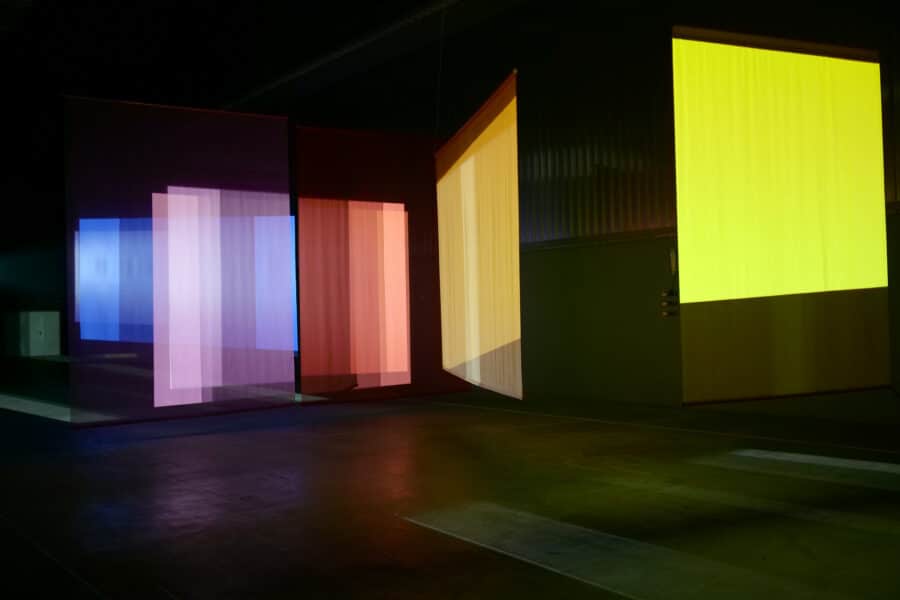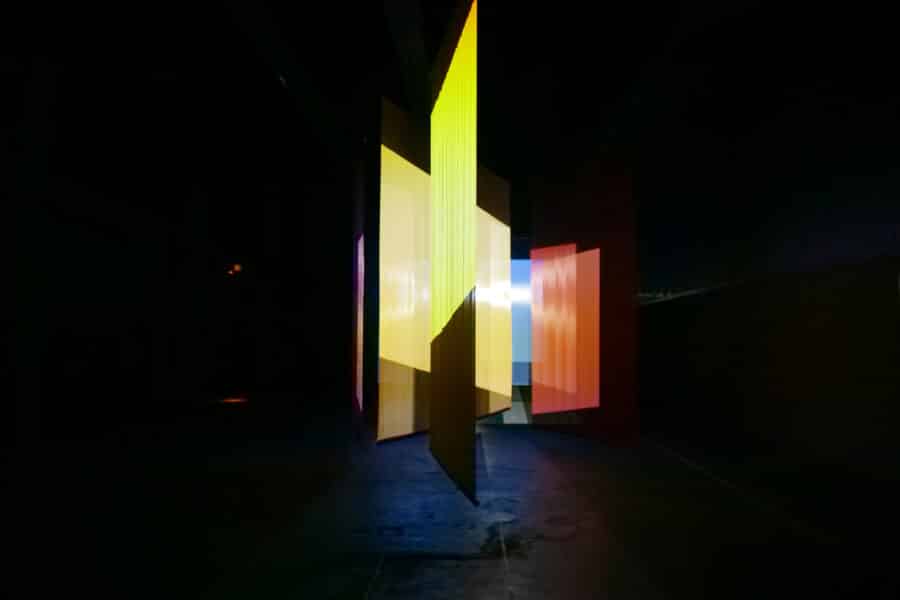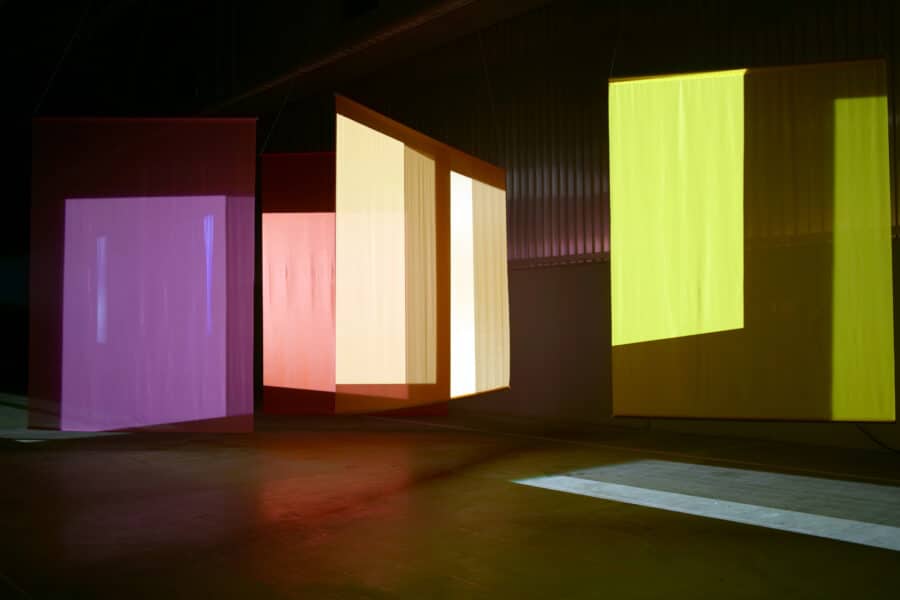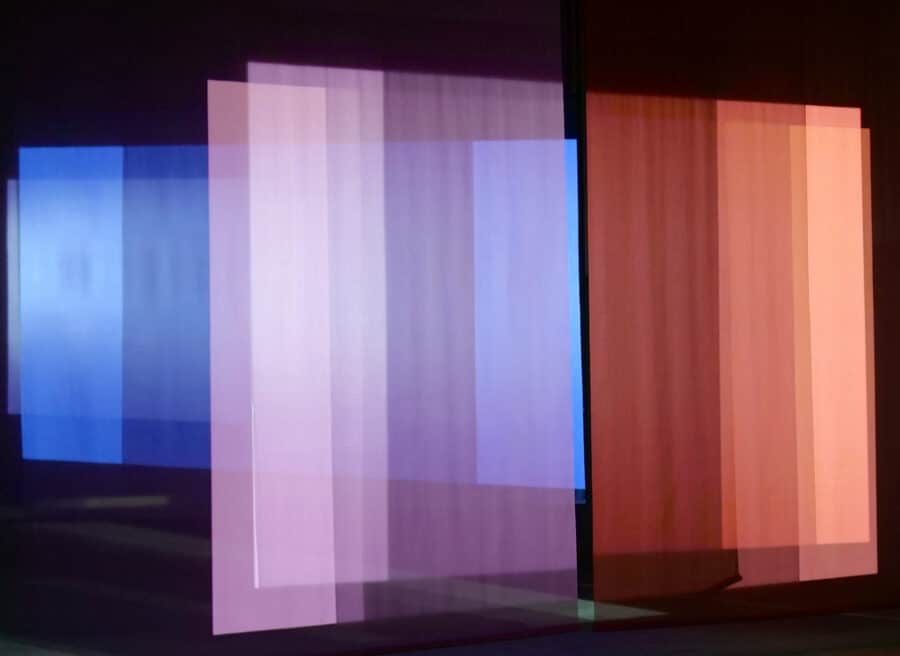SCENOGRAPHY OF SPACE, Kurzfilm Festival Hamburg, June 2023
An inspiration for this installation SCENOGRAPHY OF SPACE, which brings together visual art & film, was Hans Richter’s film “Rhythmus 21”. Hans Richter was an important 20th century German artist and filmmaker known for his avant-garde works. One of his notable films, “Rhythm 21” from 1921 is considered one of the earliest abstract films ever made and has been called a “key film of modernism.” In this film, Richter explored the representation of abstract forms, movements, and rhythms. The film consists of trick moving geometric shapes and patterns. Black and white squares appear in fades up and down on the screen. They sometimes appear to move from one side of the frame to the other, sometimes from foreground to background.
Rhythm was shot in black and white and lasts about 3 minutes – as does the installation Scenography of Space. “Rhythm” had a profound influence on many subsequent artists and filmmakers and, as stated earlier, also served as inspiration for Luftwerk. Luftwerk’s artistic practice, with its emphasis on light, color, and choreographed projections, is conceptually related to Richter’s exploration of abstract forms and rhythms. Luftwerk’s work extends Richter’s legacy and bridges the gap between film and visual art. By incorporating light projections and techniques (in Luftwerk’s case: motors / fabric panels), they push the boundaries of the medium and develop a unique visual language, expanding the possibilities of film and visual art through their innovative and boundary-breaking approach.
And while we’re on the subject of perception, we’re also in NOW, our theme of the Hamburg Short Film Festival. An expanded concept of media art also includes the use of light and movement as artistic material. As early as the 1950s, artists of the ZERO group such as Heinz Mack, Otto Piene and Günther Uecker were concerned with light as a creative medium. Their concern was to trace painting back to its conditions, namely in particular to light as the underlying element. In doing so, however, they left the technique of painting with paint and canvas and created spatial works that cast shadows or evoked reflections and incorporated movement into their concept. The result was works whose impression changes depending on the viewer’s point of view. Heinz Mack does not consider color or other formal components, but their spatial organization and movement as the actual form of artistic work.
Scenography of Space by Luftwerk also works as a space-related artwork with the integration of a variable viewer perspective. As the:visitor:walks through the space, there is no fixed viewer standpoint that dictates an optimal perspective of perception. Movement and orientation in the space is an intentional element of the visitor experience.
— Melike Bilir —
- Curator
- Maike Mia Höhne
- Produced by
- Kurzfilm Hamburg
- Technical Production
- 24Frame
- Photography
- Claudia Höhne
SCENOGRAPHY OF SPACE, 2023
Two-channel video installation, six moving screens in varying sizes and colors, six disco ball motors, 4mH x 15mL x 6mW, 2023
Licht auf Licht auf sich wandelnden Flächen.
Der flüchtige Raum.
Text by Melike Bilir:
“Mehr Licht” (“More light”) Goethe said on his deathbed. As an artist and scientist, the longing for more light drove him throughout his life. Not only during the Romantic period, but throughout the ages, pharaohs and astronomers, philosophers and physicists, priests and painters have sought methods of understanding light and becoming powerful with it. Cultural history is rich in myths and legends, theories and inventions. They are all about the essence of light, as it is part of our experience and consciousness.
Light is all-embracing and touches all areas of human life. The philosophers of antiquity were the first to systematically include light in their theories. For almost 1000 years, the Platonic doctrine, which primarily emphasized the spiritual-internal dimension of light, was the basis for all subsequent lighting concepts – from optics to architecture to philosophy. With the beginning of the modern era, it was displaced and thus light was deprived of its spiritual reference point. This break marks a decisive moment in the history of light and is the basis for our understanding of it today.
In the 21st century, the character of light is being discussed anew. Light shapes life and thus culture. Electric light is the basis of our modern economic and social system. The significance and effect of artificial light on people, aesthetics and space is up for debate.
And this is where Luftwerk comes in: Luftwerk (Petra Bachmaier & Sean Gallero) explore light, color and perception in their installations. Since their founding in 2007, Luftwerk has created an extensive body of work ranging from site-specific installations to experimental projects. Petra Bachmaier, holds a Master of Arts from the HfbK in Hamburg and a Bachelor of Fine Arts from the School of the Art Institute in Chicago (SAIC). Sean Gallero, studied art and humanities at Lehman College in New York. He continued his studies at the School of the Art Institute Chicago (SAIC), where he began his collaboration with Bachmaier in 2000.
Light and color are the most important elements in Luftwerk’s work. Their interest is in the power of light as a crucial element of vision, whose dynamic relationship to color perception is explored. Through the use of various modalities – such as projection of videos, shadow casting, among others – they integrate light into each project to explore its fleeting and changing nature. Essentially, Luftwerk creates visual atmospheres through the use of light and manipulates the viewer’s attention with vibrant colors to create intriguing experiences. Petra and Sean describe that in every Luftwerk project, color is the key and light is the core. The combination of light and color adds a dynamic layer to their work that changes the audience’s perception.
What I would also like to point out: despite many innovations, LIGHT drags all this tradition of mysticism and symbolism with it. All the time it had something to represent: Christ, divine inspiration, truth, enlightenment, even socialism. In general, light has always been used primarily to reveal other things. Luftwerk is about light revealing itself as light. The light doesn’t symbolize anything else. It is what it is. Freed from traditions, mysticism and symbolism, they treat light as matter – as material.



